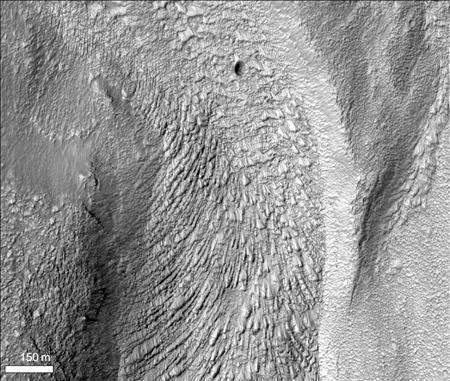Computer models of Earth's climate change confirmed on Mars
Date: 17-Oct-12
Country: USA
Author: Deborah Zabarenko

In this undated orbital photos from NASA Mars Reconnaissance
Orbiter, this closeup view shows chevron texture on riverbed floor,
indicating how the ice-rich material flowed fastest in the middle
and was retarded along the channel walls.
Photo: NASA/JPL/Handout
Computer models have accurately forecast conditions on Mars and are valid predictors of climate change on Earth, U.S. and French astronomers said on Tuesday.
These computer programs predicted Martian glaciers and other features on Earth's planetary neighbor, scientists found.
"Some public figures imply that modeling of global climate change on Earth is 'junk science,' but if climate models can explain features observed on other planets, then the models must have at least some validity," lead researcher William Hartmann of the Planetary Science Institute said in a statement.
The team's findings were presented at the annual meeting of the American Astronomical Society's planetary sciences division in Reno, Nevada.
Some climate change skeptics, notably U.S. Senator James Inhofe, an Oklahoma Republican, dismiss human-spurred global warming as a hoax. Others accept that Earth's climate is changing, but discount a human cause. Still others, including Republican presidential nominee Mitt Romney, accept the idea of climate change, but maintain the science is inconclusive.
The science of climate change prediction is dependent in part on complex computer models that take into account multiple factors that influence Earth's climate, including the level of carbon dioxide and other greenhouse gases in the atmosphere.
Many such models have forecast the globally averaged temperature will rise by 3.6 degrees F (2 degrees C) this century if greenhouse emissions continue at current levels.
Recent global temperature increases support these predictions. On Monday, the U.S. National Oceanic and Atmospheric Administration reported that September 2012 was tied for the warmest month on Earth in the modern record, and was the 331st consecutive month above the 20th century average.
MODELING MARTIAN SNOWS
Hartmann, a senior scientist at the nonprofit Planetary Science Institute in Tucson, Arizona, said he and his team confirmed the earthly computer models' effectiveness by using them to forecast conditions on Mars.
New satellite observations of glaciers, ice flows and other features on the red planet showed that the models' predictions corresponded with what was on the Martian surface, Hartmann said in a telephone interview.
One key difference between Earth and Mars is their tilt, he said. Earth's axis is fixed, with very small variations, at 23.5 degrees, held steady by the gravitational pull of our moon. This tilt is responsible for changing seasons as Earth moves through the year, alternately tipping its northern and southern hemispheres toward the sun.
Mars lacks a big moon to stabilize its tilt, and its rotational axis can vary as much as 70 degrees toward the sun. When that happens, polar ice evaporates and puts moisture into the Martian atmosphere, which dumps snow, ice and ultimately glaciers in Mars' mid-latitudes. The last time this happened, astronomers say, was between 5 million and 20 million years ago.
Factoring in the planet's varying tilt, topography, atmosphere and other information, the climate models forecast specific regions for massive snowfalls, and the remnants of those snowfalls are right there, Hartmann said. So are ice flows and other features, viewed by NASA's Mars Reconnaissance Orbiter.
"We do have a lot of public figures, in our country particularly, saying that the global climate modeling studies have very little value," Hartmann said. "If the global climate modeling people can run these models on Mars and we actually see things that come out of the model on another planet, then the climate modeling people must be doing something right."
(Reporting By Deborah Zabarenko, Environment Correspondent; Editing by Stacey Joyce)
![]()
© Thomson Reuters 2012 All rights reserved